
MAY CONTAIN NUTS

Search Shorpy
SHORPY ART

Framed or unframed, desk size to sofa size, printed by us in Arizona and Alabama since 2007. Explore now.
Join and Share
Ad-Free Shorpy
Shorpy is funded by you. Patreon contributors get an ad-free experience.
Learn more.

Recent comments
- Alas, hidden from view
- Exclusive pump
- Details, Details
- What's that building to the left of the tower?
- Coal Barges
- Bromo-Seltzer
- Inner harbor
- The Basin
- What a headache!
- Giant stepladder?
- Baldwin 62303
- Baldwin VO-1000
- Cold
- No expense spared
- Tough Guys
- Lost in Toyland
- And without gloves
- If I were a blindfolded time traveler
- Smoke Consumer Also Cooks
- Oh that stove!
- Possibly still there?
- What?!?
- $100 Reward
- Freeze Frame
- Texas Flyer wanted
- Just a Year Too Soon
- WWII -- Replacing men with women at the railroad crossing.
- Yes, Icing
- You kids drive me nuts!
- NOT An Easy Job
Member Photos
The Shorpy
Print Emporium
Print Emporium
Search Shorpy
Search results -- 30 results per page
- Gas Shack: 1920
- Washington, D.C., in 1920. "Penn Oil Co., 16th and M Sts." Pardon the mold. National Photo Company ... to wonder Where did they find room in that tiny service station building for the self-serve coffee counter, the doughnut rack, the ... architectural jewels of the Minute Service stations, the Penn Oil Co. was content to vend gasoline from simple shacks. Also ... Posted by Dave - 09/13/2011 - 11:39pm -
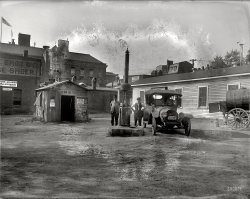
- Ghost Coach: 1930
- ... Livestock pens were near the one W&OD RR's freight station for the Cavalry horses and or livestock being shipped to and from the ... yard to Union Station.
If memory serves me correctly, Penn RR did invest in the W&OD briefly. This may be of that brief period. ... Posted by Dave - 07/22/2012 - 7:02pm -
![Ghost Coach: 1930 Washington, D.C., or vicinity circa 1915-1930. One of three H&E glass negatives labeled "Car exterior. Washington & Old Dominion R.R." Harris & Ewing Collection glass negative. View full size. The others are here and here.
Mail CarThat was a mail car, usually the first car behind the tender car.
All Aboard for Petticoat Junction!But where's the rest of the Hooterville Cannonball?
Combination CoachThis old gal carried passengers as well as mail and parcels between cities. One great picture and she was probably on her way to the scrap yard.
Good EngineeringThis is obviously an OLD car by 1930, built maybe at the turn of the century, yet look at its excellent construction. 6-wheel bogies with elaborate suspension for a smooth ride, the long chassis still straight as an arrow despite its age, lots of elbow room inside with elegant clerestory windows and lots of ventilators. This was the product of a thriving American transportation industry at the top of its game.
Pretty butOld coaches are the same this side of the water; lovely to look at and deadly dangerous if there's a crash. There's breakable, splintering, flammable wood, gas lighting in some cases, paraffin or kerosene in others. In Britain's worst train crash -- at Quintinshill during the first World War -- I believe more died in the fire afterward than in the impact.
4928Perhaps this was a mail car or a car with space for freight, but there is also obvious passenger seating in it as well. And if it typically traveled just behing a tender, why would it have that "porch" on its freight end?
Cue the Ghostly OrchestraClang, Clang, Clang went the Scary Trolley!
Ding, Ding, Ding went the Bell of Death!
Zing, Zing, Zing went my heartstrings as we started for Spookington Dell!
And this car isA 1908 PRR roster shows this as a Class OK combine (baggage/coach) built in 1900 and owned by the PB&W (the subsidiary of the Pennsy that owned the tracks on the line from Philly to DC). These cars were rebuilt with full vestibules at some point, because there is a diagram for that configuration; obviously this one escaped. Apparently these cars always had steam heat. There were three different subclasses depending on the size of the baggage compartment; this is the smallest, with the 20-foot compartment.
The six-wheel trucks show that this is a "heavyweight" steel car. The interior appears to have walkover seats so the car doesn't have to be turned. Platforms (and later vestibules) were typical on baggage cars to allow train crews to pass through while in motion.
The Ghost CarI agree with the first description of this car's origins. The car was still on the PRR roster on 1-1-1914, but was gone by 3-1-1916. The lettering couldn't have lasted 14 years. My guess is the photos were taken shortly after sale to the W&OD. Moreover, the truss rods under the center of the car indicate that this was a fully wooden car both when it was constructed and when these photos were taken.
Further ResearchI've come across a classification guide which indicates that class O cars are wooden combines. Class PB steel combines in the same guide are only about 10 feet longer, but weigh 50 percent more (120,000 vs. 80,000 pounds).
Checking in Ames's book on the W&OD, I see absolutely no evidence that this car was ever used on that line. Passenger operations were electric, with the exception of several 1878/1887 coaches purchased from the Manhattan Electric Rwy which were considerably older in design than this car. The only combines on the roster were either electrics or doodlebugs. My guess is that this car was just passing through.
[I think there was probably another reason for taking these photos. - Dave]
PilotThis car seems to have a tube pilot on the far truck, which might indicate it was used behind an interurban or box motor in push/pull service.
Thoughts on the Mystery CoachChecking Herb Harwood Jr.'s "Rails to the Blue Ridge: The Washington and Old Dominion Railroad, 1847-1968" I find no reference to any ex-Pennsylvania railroad coaches in the company's roster. That being said, I have a couple of ideas.
As far as the location of the photograph, the coach appears to be sitting on one leg of a wye, used for turning locomotives or whole trains (given the length of the stub track, just locomotives in this case). According to Hardwood's track map, and assuming this is the Washington & Old Dominion Railroad, that leaves four possible locations for this photograph: Bluemont Junction, Herndon, Leesburg, or Bluemont. Given the topography in the background, and having bicycled the W&OD quite a lot, I would suggest the likely location of this to be Bluemont Junction.
I have come up with one possible explanation for why this coach never appeared on the company rosters. It is possible that this coach was purchased by the Washington & Old Dominion Railroad, but never operated over the line, and simply sat disused in its location pictured. The three-axle trucks indicate to me that the coach is possibly quite heavy, perhaps too heavy to operate on the W&OD's light rails. It certainly would not have been the only instance of a railroad purchasing equipment too heavy for its rails. (In my home province of Ontario, one of the two locomotives of the Huntsville and Lake of Bays Railway was found to be too heavy and remained stored during its 11-year career on the railroad).
One other possibility that has come to mind is that this is not the Washington & Old Dominion Railroad at all, but rather the Rosslyn Connecting Railroad which branched off the current rail line as it reached the Virginia side of the Potomac, and headed north to Rosslyn. This railroad was a subsidiary of the Pennsylvania Railroad, which would explain the coach. If the photograph was simply labeled (Washington DC area), it is possible that the railroad was misidentified. This, however, is complete conjecture, as I am not even sure whether passenger service was ever operated (or intended to be operated but wasn't) over the Rosslyn Connecting Railroad.
[The photos are labeled as indicated in the caption. - Dave]
One thing I can say for surethe number designations on the car are most definitely
"Pennsy".
That font is unmistakable.
#4928 Pennsylvania Combination carMy opinions are just that--pity the photographer isn't alive to comment. That said:
I disagree with the car going to scrap. The gas light globes are still inside the interior. If it is to be scrapped all the parts to keep for repairing/building other cars would be removed first.
In the American Civil War, cars from other railroads were often borrowed to move troops. This inter-rail cooperation worked well-- There are several military grounds near the W&OD RR. Fort Myer, Va. and Camp Auger, near Merrifield, Virginia - off the Dunn Loring RR stop on the W&OD line. Livestock pens were near the one W&OD RR's freight station for the Cavalry horses and or livestock being shipped to and from the more western towns, e.g. Herndon, etc.
Military grounds near railroad lines would be Camp A. A.Humphreys aka Fort Belvoir, Virginia; Quantico, Virginia which are off the Alexandria Railyard heading south on the Southern, Richmond, Fredericksburg & Potomac line. On the Mt. Vernon line, it could have gone by Fort Marcy.
It could have easily been sold to Virginia Central Rwy or the Fruit Grower's Express Rwy, for the use of the company's executives or for an occasional run for passengers; e.g. executive use, party, etc.
It may be entirely possible that this car never went past the railroad bridge into Virginia. It could have easily been sold to a short line (East Washington, Rwy)and or sitting in the more rural sections of Washington, DC around Ivy City--a connecting yard to Union Station.
If memory serves me correctly, Penn RR did invest in the W&OD briefly. This may be of that brief period.
A combine, but not for mailThese three pictures show a rail car that once ruled the main line but now has been modified for a lowly afterlife on a forgotten branchline. The car has a 20-foot compartment for freight and express at one end. The pigeonhole box near the roof line being for small packages and company mail moving from station to station. If it were a US Mail compartment, there would have been the mandatory fixtures for bags, pouches, sorting tables and sorting racks - plus there would have been a letter drop slot on the side of the car. The rear section offers walk-over coach seats.
We can see this was a mainline car account of the six wheeled trucks, walkway buffers and the three hoses next to the coupler. One hose was for airbrakes, one was a communication line to signal to the engineer by the train crew, and one was for steam heat. The pilot (or cowcatcher to some) on the far end of the car implies some type of push-pull service.
If this the W&OD, I believe they had some self-powered "doodlebug" cars and this car could have served as a trailer being pulled along by the power car, until it was time to return and the train was shoved back towards its origin. A procedure quite effective to give the engineer a cramped neck, and the flagman the worry of being on the cutting edge of any grade crossing incident with a car or truck. The flagman usually manned a little peanut whistle powered by the air line that he would signal with as the train approached crossings and stations.
The carHere is a link that refers to this car.
(The Gallery, D.C., Harris + Ewing, Railroads)](https://www.shorpy.com/files/images/20626a.thumbnail.jpg)
- Street View: 1922
- ... There's lots of Shorpy's in there ... the gas station next to Ford's Theater
... yesterday's bus full of telephone ladies ... today, incorporated into the east elevation of 1001 Penn. Ave NW.
Epiphany epiphany Re Epiphany, answering my own question: ... Posted by Dave - 07/17/2012 - 10:17pm -
![Street View: 1922 Washington, D.C., circa 1922. "Star Building from air." The Washington Star newspaper building at the center is at the intersection of 11th Street N.W. and Pennsylvania Avenue, which runs diagonally across the photo. The big building with the tower us the Old Post Office. There's a lot to see here, including laundry hung out to dry. National Photo Company glass negative. View full size.
Timber!I wonder what the story is on the collapsed building in the lower right corner behind the markets. Wonder if it was just a building collapse, or was there a fire there? And Maharg is right, when you think of Washington, you think White House, and National Mall, you forget that its a city full of people just like any other.
Also notice, the Washington Times billboard just one block away from the Star Building.
Teeming with commerceWhen you grew up in the hinterlands and Washington was, to us, "Our Nation's Capital," you didn't really get the idea that real life teems in those streets, that Washington is as much a city of commerce as it is a city of government. Extraordinary photo, a Shorpy great!
Electric RailwayIn the upper right corner is the terminal for the short-lived Washington, Baltimore and Annapolis Electric Railway, which ended service in 1935. Pretty amazing the amount of markets and street-vendor setups surrounding parts of Pennsylvania Avenue in the central portion of the city just south.
Wow, how times have changed.Wow, how times have changed. One of my favorite restaurants is now in the Star Building. I love how there is so little traffic. Thanks for the photo!
Then and NowI would love to see a shot taken of the same angle today.
To market, to marketThe market building with the metal bay (foreground center) is the same one seen here. Also note the tall building upper-leftish with the covered airshaft or center bay. That must have been a dreary view. And yes, those are binder holes along the left. This is a photo of a photo of a photo. Imaged from a glass negative of a paper print. So we are third-generation here. Still, not bad.
Fire!I wonder what the story is on the collapsed building in the lower right corner behind the markets. Wonder if it was just a building collapse, or was there a fire there?
The 1913 Baist Atlas available from the Library of Congress identifies this as 910-912 Pennsylvania Avenue. The 11/28/21 Washington Post reports that it housed a furniture warehouse, H. Baum and Sons, that burned in a fire the previous afternoon (see "$200,000 Avenue Fire", pg. 1).
There's lots of Shorpy's in there... the gas station next to Ford's Theater
... yesterday's bus full of telephone ladies
Fire Sale!Looks like the street on the near side of the burned out building is full of fire sale items.
Re: Fire!Here's hoping that H. Baum and Sons took advantage of the "Absolutely Fire Proof" United States Storage Co. just down the street for any irreplaceable items or documents!
Garfield shooting siteI just realized that bottom center is the location of the train station where President Garfield was shot, 41 years before this photo (though he survived for 80 days), on the site of the current National Gallery of Art.
[The current location of the National Gallery isn't in this picture; it would be off the the bottom right. Garfield was shot at the Sixth Street Station; the intersection at the bottom right of this photo is Pennsylvania and Ninth. - Dave]
Windows Windows Everywhere!!!This is one magnificent photo. I enjoyed seeing the overhead view of the Loew's Palace and the New National Theaters. I challenge any Shorpy viewer to count the vast number of windows that show in this field. Would it be close to maybe 5,000?
Re: FireThanks Rock for the info, it's amazing the amount of knowledge that can be gleaned from the users here just by putting up a photo. Thanks Dave.
Joe from LI
Church of the EpiphanyUnless I'm very confused, the building (top center) surrounded by scaffolding is the bell tower of the Church of the Epiphany at 1317 G St NW. Wonder what they were doing: erecting or repairing?
Re the United States Storage Co., the 10th St facade of that building remains today, incorporated into the east elevation of 1001 Penn. Ave NW.
Epiphany epiphanyRe Epiphany, answering my own question: the tower was remodeled in 1922.
Also visible at the top of the photo are:
1) the original NY Ave Presbyterian Church (dark & squat). The photo doesn't show the top portion; if it did, we'd note the missing steeple (destroyed in an 1898 storm). The building was razed & rebuilt in a larger form by the congregation in 1950.
2) the old Masonic temple.
(The Gallery, D.C., Natl Photo)](https://www.shorpy.com/files/images/30428u-aerial.thumbnail.jpg)
- Hard Copy Exterior: 1962
- ... Stands Up To Khrushchev?" "Studebaker Autos Not Selling?" "Penn Station To Be Torn Down?" "Captain Kangaroo Show A New Hit With Kiddies?" "Sox ... Posted by tterrace - 06/24/2009 - 4:53pm -
![Hard Copy Exterior: 1962 A garden, a deck, a barbecue, the family dog and the papers. My father, after a day at work, relaxes in his domain in 1962. You don't get more echt than this. He created the deck and the lattice fence as well as surrounding gardens, a very small portion of which is at the top. Our BBQ seems starkly low-tech these days. No starter fluid for Father; that's a box of kindling at the bottom. Snapped with my Kodak Brownie Starmite. View full size.
Mmm-mmm good.Nothing better than a steaming mug of barbecued coffee!
Grill master.There is nothing not to like about this pic. The grill, the dog, the deck, and Dad with the news. Wonderful.
Terrific SceneThis is a view right out of Sunset Magazine, really nice!!!
It's always interesting to peer into other people's back yards --
Old school grillingYour dad probably would've been appalled with at my grandpa -- he had a beer can with the top cut off that he filled with gasoline to light a nearly identical Structo grill when I was a small Anonymous Tipster.
MemoriesMy dad had the same grill when I was a kid. I still remember the hand crank on the side that would move the entire coal bed up and down to adjust the heat. And of course the bags and bags of charcoal briquets in the garage and that aweful smelling lighter fluid that would create a mushroom cloud when lit.
The only thing missing in that pic to be my dad is a beer on the deck next to his chair.
And no mosquitoes!Maybe it's because I was a Boy Scout, but I'm with your dad. Who needs lighter fluid? Our briquets start right up with a few twigs that have fallen out of the trees. And no icky taste from the petroleum. Now, barbecued coffee ... that's something I haven't tried.
Boxer or -- ?What kind of dog did you have?
BBQ dogOur dog Missie was hybrid beagle/undetermined mix, hard-wired to point and track. During our summer vacation hikes up in the hills between Guernewood Park and Cazadero, she'd disappear into the underbrush for hours sniffing out critters, finally tracking us down miles from where she'd left us. The crank on the BBQ raised and lowered the grill, not the coals, BTW. We purchased it partly with funds I collected as taxes a few years before when I incorporated our entire back yard as a city and appointed myself City Manager. 10¢ per week was the rate, as I recall.
He's got a barbecue jonesMy dad was also big on outdoor grilling, but my memories aren't of him sitting alone, but rather of the big parties that he and Mom would host at our Jersey Shore summer house, on the big back lawn shaded by an ancient apple tree. Dad went in for the whole 60's-70's BBQ thing, standing behind the grill with a chef's apron and toque on, and wielding his cooking tools with great gusto. The beer flowed freely, too (there was always a keg at the larger gatherings).
When he died, more than one person told me, "What a host he was! What a cook!" He was a government official, but I suspect that he would have been much happier owning a fine restaurant instead.
My grandpa used gasoline...My grandpa built his own grills out of 50 gallon drums he would get from the oil refinery where he worked. I remember as a kid back in the '60s helping him put gasoline in a coffee can that he used to soak the charcoal briquets and then stack them up in the grill and throw a match at it. Worked every time!
A summer idyllA beautiful scene, the epitome of the American Dream. Thank the gods, we still enjoy similar scenes at our summer bungalow co-op in the shadow of Shawangunk Mountain, Ulster County, NY; eagerly awaiting same, now, during this protracted winter season. We don't BBQ coffee, but we do enjoy fantastic beer-can BBQ chicken. Except we all have cats frolicking and lurking in the hedges and woods. Cats rule, dogs drool.
That device is a grillBarbecue is something you eat (pulled pork, ribs, brisket) and a grill is something you cook on. And cooking on a grill is not "barbecuing," it's grilling.
[A word can have more than one meaning. The device is called a barbecue grill, or barbecue for short. In fact the first definition of "barbecue" in Webster's is: "an often portable fireplace over which meat and fish are roasted." - Dave]
Still likely nowCtheP, I don't want to distract from tterence's great photo, but your comment is inaccurate in several ways. About the only thing that has changed much since that afternoon when his father was enjoying his paper is what we consider to be "basic necessities" is far in excess of what was considered "basic" back then. It should be no surprise that it costs more to fund our lifestyle.
For example, just look at today's average home sizes, frequency of new car purchases, number of cars per household, value and quantity of home electronics, number of times people eat out, the list goes on. In many ways, things are astonishingly cheap these days, it's just that we have much more of them.
You have to get a permit to build a deck because a lot of "handymen" don't know how to do it right--their deck falls off their house, hurting or killing someone. (It's been said that behind every code item there is a death.) It's unlikely a simple deck would need a variance from the city, though if you opted to buy in a HOA community, their hoops are something you valued when you bought and have little to complain about if they deny you your deck.
As to "savers" paying the mortgages of those who got in over their heads, that's silly. What "savers" are paying for now is the multi-million dollar bonuses of the country-club set who approved those crappy loans. A mortgage is a simple document at its heart; a lender agrees to lend money to buyer of a house with the understanding that if the buyer cannot pay, the bank gets the house in lieu of payment.
In a sane world, such as existed in tterence's father's day, banks very carefully determined the value of the house they were lending on in order to ensure they'd come out whole if everything went south. They were careful about the buyer, too, and insisted the buyer bring a large down-payment in order to show their worthiness.
If the bank is going to go out of its way to lend money to people who shouldn't be buying vastly over-priced houses, that sounds like the bank's problem to me. That we're bailing out the fat cats irritates me, but I have no issues with the home buyers. I wish they were more prudent, but when they mail the bank the keys they've done their part. They will have trouble getting another mortgage in the future, that's the price they'll pay.
So I think I'll join tterence's father, at least in spirit, on his deck, and not pretend life was much better "back in the day." I doubt his father felt that at the time and I don't think that now.
The Right IdeaAlthough as a kid I was a devoted user of lighter fluid, your father had the right idea with the kindling. No matter what they included in the fluid to make it small like hickory or whatever, the lighter fluid was always going to give a petroleum based smell to the smoke, which was half the charm of barbecuing. These days I use propane of course, but I feel like I'm missing something.
Not likely nowMy guess (correct me if I'm wrong, tterrace) is that your father worked long hours while your mother raised the family. Even then, he could afford a nice deck (your post suggests he built it himself) and a nice yard. I imagine he wanted a deck and all he had to do was buy the materials and erect it -- no permission necessary, as it was his property. Now, he'd need a variance and probably have to pay for the privilege of improving his own property as he saw fit.
Today, those things are almost a luxury. Dad and Mom work to buy all the modern devices (even the "poor" have cell phones, DVD players, iPhones, etc.) while those of us who work and save get shafted to pay the mortgages of those who got mortgages they knew they couldn't pay for in the first place.
Neighborhoods are cookie-cutter, and God help you if your neighborhood association doesn't like the new mailbox you put up to replace the one the neighborhood thugs tore down.
Freedom was a wonderful thing. Damn shame the sheeple decided they'd rather let the government take care of them than provide for themselves.
That GrillMy dad had a grill just like this one. He placed an inch or so of gravel in the bottom to keep the fire from burning through. Had an old license plate bent into a cylinder that he would place the charcoal into to start the fire. The grill lasted into the late 70s..
Headline NewsI would love to know what the headlines say!
What DO those headlines say?"JFK Stands Up To Khrushchev?" "Studebaker Autos Not Selling?" "Penn Station To Be Torn Down?" "Captain Kangaroo Show A New Hit With Kiddies?" "Sox Lose Series, Again?"
Make up your own, the possibilities are endless...
BBQ HeadlinesLooks like the San Rafael Independent-Journal.
Man's home is his castle.The tterrace family lived right and they lived well. It is apparent that they all had traditional and responsibly-fulfilled roles of their position in the family. I have to say, I do miss those days, coming home, tired and hungry, to incredible smells of freshly cooked food being prepared for supper by Mom and having a pleasant evening at home at the end of the day with the comfort of a caring family all around. As we age, we realize that changes are inevitable and one really cannot go back, life never stays the same. Still it is a beautiful picture to remember and know that home is where the heart was. It certainly appears there was great contentment in the family of tterrace. Thanks for the memories.
GrillingLike most of us, I use a gas grill today (natural gas, not propane, though). However I still have a Weber charcoal grill which I refuse to discard, despite my wife's urgings. Unlike many, I do not use lighter fluid, though. Long ago, I learned the advantages of an electric fire starter for a charcoal grill. You have better control over the process, and you can start the fire under a wooden deck without any worries. I have used the quick start saturated coals, but still prefer the electric starter. In any case, gas is easier, but something is missing in the taste.
(ShorpyBlog, Member Gallery, tterrapix)](https://www.shorpy.com/files/images/bbq_1.thumbnail.jpg)
- Pittsburgh Rising: 1908
- ... PJ McArdle meets Grandview Avenue. Incredible that the Penn Incline (running behind the Pennsylvania Station) looks as close as it does, given that it was near 17th Street. Any ... Posted by Dave - 07/19/2012 - 10:20pm -
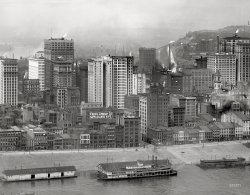
- Special Delivery: 1917
- ... That would mean that this could be the post office on Penn between 12th and 13th.
Cool it ain't Do you suppose these men ... Office (now the National Postal Museum) adjacent to Union Station. Here's the spot today, on North Capitol St. NE.
View ... Posted by Dave - 08/27/2012 - 2:41pm -
![Special Delivery: 1917 Washington, D.C., circa 1917. "Post Office postmen on scooters." Kind of a Segway vibe here. Harris & Ewing Collection glass negative. View full size.
Cool old scootersEarly Autoped Ever-Ready scooters. They were new in 1914, according to Wikipedia, so that narrows the date of the photo down a bit.
[Thanks! Below: Article from 1914, ad from 1916. - Dave]
I wonderI wonder why these didn't catch on? They look almost identical to some of the *extremely* noisy motorized scooters we have today. Perhaps they broke down, or they made an ungodly racket, or people just weren't so walking-averse as they are today.
Wonder no more:You hit a small rock or crack in the pavement and over the handle bars you go. Perhaps too many carriers were going onto the injured list.
Flash in the Pan?Looks like they had the staying power of Segues, also.
Smithsonian has oneIt's here. A 1918 model with some usability improvements but not as spiffy looking.
HuminaThey don't make mailmen the way they used to.
Pretty simple design.Looks like its basically a horizontal shaft engine with the front wheel being attached to the shaft, with some sort of clutch mechanism. Guess it gave mailmen the chance to get away from the local dogs.
ReflectionsIn the window, you can just barely see a sign for the Hotel Harrington (which would put this at least after 1914). That would mean that this could be the post office on Penn between 12th and 13th.
Cool it ain'tDo you suppose these men felt as dorky as they look?
Precursor to SegwayWow, you'd think we would have learned our lesson already. Remember how the Segway was going to change the world?
I think they are used in Post Offices (somewhere), and I have seen police use them.
Scoot!"Wow, you'd think we would have learned our lesson already. Remember how the Segway was going to change the world?"
Not at $5,000 each (the price that I've seen), they wouldn't.
Special-Delivery MessengersThese aren't regular letter carriers, aka mailmen, but special-delivery messengers. According to Sec. 864 PL&R (Postal Laws and Regulations) of 1913, these could be, at the discretion of the local postmaster, "boys 16 years of age or older." Contemporary Special Delivery postage stamps bore illustrations of such uniformed boys riding on bicycles:
The Mailman ComethI second your comment with a hubba hubba. Forget the milkman, bring on the mailman!
Scooter spot todayThis was at the Main Post Office (now the National Postal Museum) adjacent to Union Station. Here's the spot today, on North Capitol St. NE.
View Larger Map
(The Gallery, D.C., Harris + Ewing)](https://www.shorpy.com/files/images/06878a.thumbnail.jpg)
- Singer Building: 1913
- ... formed after the outcry over demolition of Pennsylvania Station. The Commission failed miserably, allowing the destruction of the ... comparison to the importance to preserve: just as we mourn Penn Station, we should mourn the destruction of those blocks.
(The ... Posted by Dave - 08/01/2012 - 5:43pm -
![Singer Building: 1913 New York circa 1913. "The Singer Building." Rising in the distance, the Woolworth Building under construction. Detroit Publishing Company. View full size.
Pie in the sky, my eyeToday the building would be converted to condos or apartments (or a hotel, like the PSFS in Philadelphia) and would be a huge success. Nobody thought of that in 1967, because ... because they didn't want to think of anything except demolition.
Here's the piece of sky-pastry that the Singer Building was swapped for:
Old and NewFor a kid who grew up in Manhattan and Jersey City, the Singer was interesting in a grotesque kind of way, like a giant rotten tooth. Aesthetically and functionally the U.S. Steel building (which will probably long outlive the Singer) was a big improvement. Still, something was lost -- it would be nice if the Singer was still there. But that's the way it goes.
Quo Vadis SingerThat is just a gorgeous building. Looks like something out of "The Fountainhead." Why on earth did they let that one disappear?
Yikes.I guess this would be the classic example of "it looked good on paper."
The more things changedThe Singer Building was the first big test for New York's Landmarks Preservation Commission, which was formed after the outcry over demolition of Pennsylvania Station. The Commission failed miserably, allowing the destruction of the Singer Building in 1967 on the grounds that there was nothing else to do with it. It is the largest structure ever demolished for "peaceful" (i.e. money) reasons.
A real shameDoing a little research, you can see that the newly formed NYC Landmarks Commission really failed its mission in letting this building be torn down. There is nothing else like it in NY. If you do a little net research, you can find some detailed exterior and interior pix. I wish I could have seen what those spaces are like up in the crown. It must have been spectacular.
Impressively somethingTop kind of scary!
Pie in the Sky NotionsI wonder what some of the commenters here are thinking -- if you are the owner or shareholder in a piece of property, the government can tell you what to do with it (including taking a loss on it) just because people think it looks cool?
There's a limit to what tenants are willing to pay per square foot in any given building -- if there's a more attractive deal elsewhere, they'll take it. And what they were willing to pay in the Singer Building was, by the mid-1960s, less than what it cost to keep the place going. So they began to bail out, starting with the Singer Company itself.
The Landmarks Preservation Law is on shaky ground when it comes to giant office buildings -- something the preservation commission recognized when it declined to give the building Landmark status. It's private property, and the owners need to make a profit -- they'll abandon their investment or sue if the government makes a move toward de facto expropriation.
Alan Burnham, executive director of the Landmarks Preservation Commission, in 1967: "If the building were made a landmark, we would have to find a buyer for it or the city would have to acquire it. The city is not that wealthy and the commission doesn't have a big enough staff to be a real-estate broker for a skyscraper."
Talk is cheapThe reason the owners "thought of demolition" was they wanted to put up a big new office building that tenants would actually want to rent, and make a lot of money. Which they have every right to do. They ended up a with a building that paid a lot more in property taxes than the Singer ever did.
It's one thing to say the building should have been preserved, but, as pointed out below, the city (meaning you, the taxpayer) would have had to compensate the owners for their lost income. The money wasn't there, for understandable reasons.
One of the all-time greatsIt's a darn shame the Singer Building was demolished. It once held the title, very briefly though, as the tallest building in the world. GlenJay's right, had any decent creative thought been given to renovating the building for lucrative use, it would still be there today instead of the eye sore called 1 Liberty Plaza.
12 Fifth AvenueI always figured that the design of the Singer Building had much in common with that of the old apartment building at 12 Fifth Avenue, on a much larger scale, of course. 12 Fifth still stands between 8th and 8th Streets on the west side of 5th. Wish I had a photo of it. I lived there for two years between 1964 and 1966. Those were the Good Old Days.
Shame to lose it, but --It's a terrible aesthetic loss but the sad fact is that a building this old generally has severe handicaps for use today. Simply rewiring it for modern power (not to mention adding modern phone and computer lines) is a tremendous expense- everything is buried under plaster and masonry. These old buildings were firetraps- vast improvements over their predecessors but still dependent on someone finding a hose or fire extinguisher not all of these buildings had sprinklers. Most of these buildings depended on an open window for cooling in the summer- to refit a structure like this for modern use you've often got to strip the interior to the skeleton. Even if you could do everything needed you're up against the reality of life in NYC- the occupancy of the building might be too small to bring in enougfh money to cover costs and taxes. It's a sad thing.
Flag RaiserI'd hate to be the guy that had to go up there to raise the Singer flag.
You can't afford it.Even by 1967 standards, which are much much looser than today's standards, the building is not a viable commercial property. Look at how SMALL the floors of the tower are - now subtract space for ( 4 ) modern elevators, ( 2 ) fireproof stairways as far apart as possible, restrooms, an exit access corridor, plus space for structural columns, ventilation, air conditioning and heating equipment, and what you have left is somewhat less than half of the floor space for rental. This means you would have to charge exorbitant per-square-foot rent just to recover the renovation costs. Maybe today you could get away with it, just for the cachet of an exclusive address, but not in 1967.
Pie in the eyeUsing some of the rational expressed and considering today's economic situation, the Statue of Liberty isn't carrying her weight and could be headed for the scrap yard.
[Maybe, if the Statue of Liberty were a privately owned office building. - Dave]
Precursor of the 1916 Zoning OrdinanceThe architect of the Singer Tower, Ernest Flagg, believed that skyscrapers that shot straight up from the sidewalk and occupied their entire sites were a menace to the health of the city. He advocated building slender towers that occupied only 25 percent of the lot area while limiting the height of the "base buildings" below them, in order to get sunlight down to the crowded city streets. This is precisely what he did at the Singer Tower; in 1916 New York City adopted his formula for the nation's first zoning ordinance, which regulated the height and bulk of New York skyscrapers until 1961.
Washington LifeYou can see a section of the roof of the Washington Life building in the lower left of this beautiful photograph. It was built in the German Renaissance Revival style, and was stunning. What is there now? A little strip park, across Liberty Street from the monstrous monolith 1 Liberty Plaza. Those blocks south of Cortlandt heading into the Wall Street area were so beautiful. I wish they had been preserved. The economic arguments are weak, in comparison to the importance to preserve: just as we mourn Penn Station, we should mourn the destruction of those blocks.
(The Gallery, DPC, NYC)](https://www.shorpy.com/files/images/4a24885a.thumbnail.jpg)
- V: 1942
- August 1942. "Crowds at Pennsylvania Station, New York." Medium format negative by Marjory Collins for the Office of ...
As a very young child during the war I traveled through Penn Station quite often and remember two details: the hundreds of model ... Posted by Dave - 09/05/2012 - 7:10pm -
![V: 1942 August 1942. "Crowds at Pennsylvania Station, New York." Medium format negative by Marjory Collins for the Office of War Information. View full size.
Sentimental JourneyAlthough it is apparent that all the men in uniform have an appointed destination and mission to accomplish, one has to wonder where all the other people are headed with children and cardboard suitcases. There seems to be no business men getting on these trains as one would see at Grand Central Station. I was in a similar line with my mother at the same place just one year later when my grandmother died in Pennsylvania and we took the night train to get there, my first experience as a youngster with a family death. Quite unforgettable.
V for Victory, and moreThe “V for Victory” banner dominating the background includes, as you see, the Morse code for the letter: three dots and a dash. Early in WW II the letter began to be used as a rallying signal, expressed by holding up one’s first two fingers with the intent of showing defiance to the Nazis. The BBC took this idea and created its V for Victory campaign, which continued through the war and essentially was used by all Allied nations and their armed forces. Mass communication then, obviously, was by radio, and the BBC gave a sound to the campaign for its broadcasts into occupied Europe by using the opening notes of Beethoven’s Fifth Symphony. I have no idea if this choice was some wry British humor or what, but Beethoven, of course, was a German.
[It was used because the opening notes of Beethoven's Fifth are three short notes and a long (da-da-da-daaaa), which corresponds to the Morse code for the letter V. -tterrace] [Ahem. That's what I thought I was saying in my first sentence, but I forgot to include the part about the notes.]
As a very young child during the war I traveled through Penn Station quite often and remember two details: the hundreds of model airplanes hanging from the ceiling (black Bakelight plastic aircraft recognition models, identical to a few I had at home) and the crowds of troops arriving and departing, as this photo illustrates. To this day I wonder about the fate of that uniformed generation of Americans that I saw; for some it had to be their last few steps on home soil.
Next weekend my wife and I will be in Penn Station en route to a place without question much nicer than the destination of many of the military men and women who visited there, all those years ago.
glass tileThat glass tile floor provided light to the tracks below. You can still see some portions of it looking up at the ceiling of the NJ Transit tracks.
Vault LightsNote the glass prism vault lights imbedded in the floor, which were used to illuminate the room underneath. As a kid I remember seeing these in San Francisco, but I think most large cities had them. There's an interesting web site that tell the full story at:
http://glassian.org/Prism/Vault/index.html
You could make millions!Every person in this photo could have become a millionaire if only he or she had the sudden thought: "Hey! Why not build wheels into these suitcases?"
Dinner in the DinerBack in the 1980s, I belonged to a singing group that performed for many "snow birds" in the Phoenix area. One of the favorite songs of our audiences was "Chattanooga Choo Choo", which includes the lyrics:
"You'll leave the Pennsylvania station 'bout a quarter to four, read a magazine and then you're in Baltimore, dinner in the diner, nothing could be finer, than to have your ham and eggs in Carolina"
As one of the oldest in the group, I had to explain what it meant, and keep reminding the other ladies that it wasn't "dinner AT the diner"! I was the only one who could remember dining cars on trains. In the early to mid 1960s, at 9 and 10 years old, I really didn't think much COULD be finer than dinner in the diner, during a cross-country train trip!
On a more serious note, I would love to be able to hear what experiences each person in this photo was having, that day, and in the next few years. Certainly, everyone in it was affected by the global war in some manner.
He's not ordering two more Pimm's CupsHere's Winston Churchill in one of his iconic images, flashing the V for Victory sign.
LIRRThe Long Island Railroad also uses Penn Station as its NYC terminus. At he time this picture was taken it was the best route to that Shorpy favorite, The Rockaways, on the Queens County Shoreline. After a 1950 fire on the tracks running across Jamaica Bay, in Broad Channel, the LIRR felt that the line was too costly to operate and they sold it to NYC and in 1956 it became the IND Subway System's Rockaway line. That opened up those great beaches to the rest of the city.
(The Gallery, Marjory Collins, NYC, Railroads, WW2)](https://www.shorpy.com/files/images/SHORPY_8d21791u.thumbnail.jpg)
- Metropolis: 1933
- ... the right of center there's a nice view of the 57th Street station of the Second Avenue El. It was demolished in 1940,* so when this ... a model of another American/New York City landmark, Penn Station. It's online in 3D (made on Google SketchUp).
... Posted by Dave - 07/17/2012 - 10:28pm -
![Metropolis: 1933 January 19, 1933. "New York City views. New York Hospital and Queens from 515 Madison Avenue." Fifty-Ninth Street over the East River on the Queensboro Bridge. Medium-format acetate negative by Gottscho-Schleisner. View full size.
One more train-related sightIn the upper left you can see the long viaduct that leads up to the Hell's Gate rail bridge. The bridge itself, not yet 20 years old when the picture was taken, is out of sight to the left.
The viaduct and bridge are still there today, used by Amtrak and freights.
Vanished trainsJust to the right of center there's a nice view of the 57th Street station of the Second Avenue El. It was demolished in 1940,* so when this picture was taken in 1933 plans for its removal probably were underway**. Two stretches of the Third Avenue El can be seen closer to the foreground, one at 55th Street and the other at 57th. It lasted until 1955, so I wouldn't imagine that it was under any sort of death sentence in 1933 unlike its Second Avenue counterpart.
There also were train lines going over the Queensboro Bridge, they lasted until the late 1950's, but they don't appear to be visible in this picture.
* = an urban legend says that the steel from the demolished el was sold to Japan, and within a couple years turned into weapons used against America
** = the Second Avenue El was to be replaced by a subway under Second Avenue, which had been in the planning stages since the 1920's. Care to guess what has never been built?
Second Avenue ElI seem to recall a short bit of poetry from e.e. cummings about a sailor killed by a Japanese shell made from a bit of the 2nd Avenue El. It's been a long time since I read the poem and I can't find my books from that course or I'd quote it.
Follow the smokestackIf you follow the smokestack at the hospital complex straight down you will find another El station -- Third Avenue. There is a water tower just to the right of it. I love this photo!
Just like a train platformMy first-ever Shorpy comment. I love this blog and this particular photo: it reminds me of a train layout with model houses, and it's inspiring!
In case anyone wants a look, I just completed a model of another American/New York City landmark, Penn Station. It's online in 3D (made on Google SketchUp).
East 54th StreetI believe that the building on whose sign the Hahn Brothers is on the north side of East 54th, between 2nd and 3rd Avenues. Almost 40 years ago, I lived in a studio apartment on the north side of East 54th, one block east of the range of this photo. The fancy El Morocco nightclub had just relocated to this block about then, with entries on both the street and avenue sides. In subsequent years, the club was never able to regain its charisma from its days near Fifth Avenue in the East Fifties.
Mystery Obelisk and CylinderSlightly to the left an below the "Storage and Warehouse" sign there is a Obelisk which appears to be a large slab, about 8 stories high, held up by triangular columns with a nearby wide cylindrical structure.
I have lived for over 50 years in this neighborhood and for the life of me can't figure out what this is. Does anyone know?
[I think you mean "Storage Fireproof." What you're describing seems to be the rooftop sign (facing away from the camera) and water tank shown below.(Update: See the next comment up) - Dave]
e.e.A reference to soldier's death from a bullet made from the Sixth Avenue El is in e.e. cummings' "Plato told," written in 1944. Urban legend or not, the idea that the Sixth Avenue El (or, in some places, the Ninth Avenue El) had gone as scrap to Japan was reported as fact by columnist Arthur Baer in March 1941 and INS reporter Jim Young in 1943. Tracing any particular pile to one particular country seems difficult, but Japan was the USA's top customer for scrap iron in the late 1930's, getting over 10 million tons of it between 1934 and 1939 (according to pre-war business pages). In any event, scrap from the Second Avenue El, demolished starting in 1942, was specifically earmarked for the U.S. war effort.
Re: Just like a train platformLoved the 3D model. I use Sketchup for work - sometimes on buildings this size, but compared to yours, my models are agricultural.
Thanks for thisI used to live in this neighborhood. I could see the building that says "Storage Fireproof" from my roof. I was a block away. Nice to see NYC without all the expensive highrises.
If this photo had a soundtrackit would be Rhapsody in Blue.
Obelisk FoundThe "obelisk" is the facade of Trinity Baptist Church at 250 East 61st Street. The cylinder is a "lantern" -- a raised skylight with openings on the sides.
View Larger Map
Rapid Transit over the Queensboro BridgeThe two rail lines that ran over the Queensboro bridge are visible as they curve to merge with the Second Avenue El. There was much opposition to the removal of El by the residents of Queens as it gave users of the Flushing line one seat service to lower Manhattan, something they still lack seventy years on from the death of the el.
(The Gallery, Boats & Bridges, Gottscho-Schleisner, NYC)](https://www.shorpy.com/files/images/05845u1.thumbnail.jpg)
- The Big Pennsylvania Hole: 1908
- ... "The big Pennsylvania hole." Excavations for Pennsylvania Station. 8x10 inch glass negative, Detroit Publishing Company. View full ... Avenue Viaduct, still quite visible from the track area in Penn. The area being excavated is currently under the old Moynihan Postal ... Posted by Dave - 08/21/2012 - 7:00pm -
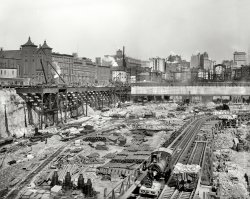
- Shop at Rosenbaums: 1941
- ... by Rosenbaum's department store (along 6th between Penn Avenue and Liberty) is occupied by a mildly interesting seven-story ... ... of the massive railroad bridge and adjoining station is the two huge brick pillars, one on each side of the river. ... it (now Fort Pitt Coffee) are still standing.
Unusual station To the left of that long steel cantilever is an interesting little ... Posted by Dave - 11/02/2019 - 5:34pm -
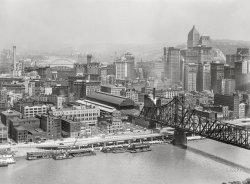
- Incognito: 1942
- ... Terminal I found a photo of the old terminal, with Penn Station in the background, on Wikipedia. That block is now home to a large ... Posted by Dave - 03/28/2013 - 9:53am -
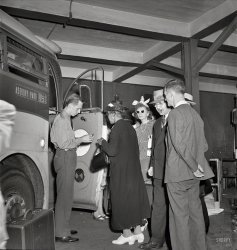
- Tremont Street: 1906
- ... it a monstrosity is the same attitude that resulted in Penn Station being demolished.
Tremont Street - Boston in the springtime ... Posted by Dave - 07/26/2012 - 4:52pm -
![Tremont Street: 1906 Boston, Massachusetts, circa 1906. "Tremont Street Bldg., looking south from Keith's Theatre." Detroit Publishing Co. glass negative. View full size.
Glass houseOn the top floor is the photo studio of "Chas W. Hearn", an expanse of glass facing the sun. Must have predated the era of electric lighting for photos, or accommodated both.
Presenting ... The FadettesI'd have paid to see them, judging from the praise found here.
In the first place, it was a pretty sight to witness these twenty or more young women in their pretty costumes of varied colors and styles, but it was when they began to play that they won the hearts of the music lovers in the audience.
The advantage of the subwayIf this picture was taken 10 years earlier, it would have shown a street clogged with streetcars. But the construction of the Tremont Street subway in 1897 resulted in a much quieter street (at least until the cars took over). I'm pretty sure the only building still standing here is the Majestic Theatre (now the Cutler Majestic Theatre and owned by Emerson College) -- off in the middle distance on the other side of Tremont with the hard to decipher neon sign on top.
A lost treasureIt was demolished in the early 1950s and for many years its former site stood empty as a parking lot. In 2004, much of that parking lot became a stage extension and loading docks for the Opera House (the former B.F. Keith Memorial Theatre).
The former entrance at 547 Washington Street still stands and is now a retail store.
From here, with lots more images and information: http://cinematreasures.org/theater/11112/
Delicious monstrosityThat is one ugly wedding cake of a building. There's enough gingerbread there to feed an army. Fascinatingly hideous!
Mitchell's StudioMitchell's sign offers 30 photos for 25 cents, your pictures on "Postal Cards" and photos for your watch fob. However, their specialty is "Ping Pongs." Could we be talking table tennis here? I don't think so. Anybody know?
["Ping-pongs" were wallet-size portraits. - Dave]
Something mundaneWe would never see a dog walking off leash by itself on a busy city street today. No one seems to being paying it any mind in this photo.
ClothingWhat strikes me most about this image is the radical and total changes in clothing styles. Less than 50 years removed from the Civil War, the men's suits look almost modern and minus the straw hats would not raise eyebrows on the streets of the 21st-century Boston. The same cannot be said of the ladies' attire. Fashion changed radically in the twenties and again in the sixties. The women's clothes shown here are a throwback to the Civil War era with hints of Victorian modesty tossed in for good measure. Some might say that men's clothing hasn't changed very much in the last 150 years excepting collars, colors and buttons. The photos I've seen of the Civil War era present a much different and far less stable picture of American trends, yet this one looks deceptively fashion forward.
The Façadeis a gorgeous example of Art Nouveau. It's something you don't see a lot of outside of Europe (in my experience), which is a shame. Calling it a monstrosity is the same attitude that resulted in Penn Station being demolished.
Tremont Street - Boston in the springtimeGreat picture of Tremont Street on what was probably one of those unusally warm April days in Boston. The young people in shirtsleeves while the older folks still wear their winter garb attests. Open windows and a few awnings add to the summery atmosphere (except for the vacant building at Keith's right.
+107Below is the same view from May of 2013.
(The Gallery, Boston, DPC)](https://www.shorpy.com/files/images/3c33476u.thumbnail.jpg)
- Retrofit: 1920
- ... Still if you look at atrocities like what was done to Penn Station vs how they restored Grand Central, I'm keeping mine intact, even with ... Posted by Dave - 08/05/2012 - 1:14pm -
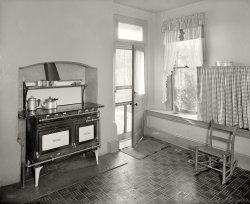
- Camera Craft: 1938
- ... photo hobby has changed so much? In my area, I would visit Penn Camera, Ritz Camera, and Industrial Photo every week. Didn't need ... the location of KFRC, the legendary San Francisco radio station of the 60's and 70's.
(The Gallery, San Francisco, Stores & ... Posted by Dave - 04/07/2017 - 9:06am -
![Camera Craft: 1938 April 1, 1938. San Francisco. "Camera Craft store, 425 Bush Street. Mr. E.R. Young." 8x10 inch acetate negative by Moulin Studios. View full size.
Elementary PhotographyThoroughly Stimulating, Expertly Written. For the Student, the Club Member, and the Amateur Photographer. By C.B. Neblette, Frederick W. Brehm, and Everett L. Priest (Macmillan, 1936). Under glass on the left, and in the middle bookshelf on the right, under the heading Latest Photographic Publications.
A professional and hobbyist dreamThis must be the most exciting camera store I have seen. So many periodicals. Looks like a hobby I would totally take up. Photography today means a smartphone app and a YouTube "how-to" video. Not nearly as interesting at all.
Looks familiarThis looks pretty much identical to any of the many Embarcadero photo stores I recall seeing during my visits there. But no doubt lacking the ridiculous markups and high-pressure salesmen of the more recent establishments.
Champlin On Fine GrainBy Harry Champlin, published by Camera Craft Publishing Company in San Francisco in 1937. A September 1981 article in Popular Photography noted that Champlin “took a dim view” of the future of 35mm film since it was too small for “the exacting demands of commercial photography and newspaper work.” He predicted 70mm as the new standard.
A Dearth of CamerasFor a camera store I certainly don't see many.
[Camera Craft was a publishing company. -Dave]
Brand NewThat looks like my Solar brand enlarger head behind the Popular Photography mag.
Camera stores!Isn't it odd that the photo hobby has changed so much? In my area, I would visit Penn Camera, Ritz Camera, and Industrial Photo every week. Didn't need anything. Just hanging out with my friends who worked there and messing around.
Days gone by. I used to love hanging around typewriter and watch repair shops, too. Chatting with folks with specialized, exact knowledge and geeking out.
Those days were such fun.
Where's the 'Phone?It's at the rear of the store, attached to a set of shelves. It appears to be a Western Electric Model 211 Spacesaver, and in this store that really is a plus.
When I was 12 my father gave me an Australian Kodak contact print set to make my own photos. It included a safe light, developing tank, trays, paper and chemicals to learn photo processing and printing. I later belonged to a camera club at school, and as an adult acquired an enlarger. I made my own prints in B&W for many years, but never graduated to colour. The enlarger resides in my attic since I went digital. I can now scan my old B&W negatives, and process them on my computer without all the liquids, fumes, etc. But I do miss the experience of visiting the camera store to stock up on supplies.
Camera Craft Still being published. Or rather being published again.
http://cameracraft.online/
Clamp lightsStill unchanged after almost 80 years!
Popular Photography 1937-2017Camera Craft may still be publishing but Popular Photography (bottom of the magazine rack) just shut down.
The Kodak LetterCurious about the "Kodak Letter" poster partly seen on the upper right, I found it was a 1918 magazine ad encouraging people to send photos to their soldiers "over there" in WWI. So it was already a vintage poster (and camera) in 1938.
[Good work. I was wondering about that thing that looks like an antique cable modem! - Dave]
Camera in "The Kodak Letter" adThe camera in the "Kodak Letter" poster from 1918 probably is
this one. It does look a bit like a cable modem when folded! I recall my granddad (who was just a bit too young for WW I) had something like this when I was small. It was fascinating.
[However, many Kodak folding cameras of the period looked like this when closed. -tterrace]
Interesting location.The location of this business would later become the location of KFRC, the legendary San Francisco radio station of the 60's and 70's.
(The Gallery, San Francisco, Stores & Markets)](https://www.shorpy.com/files/images/SHORPY-1124.thumbnail.jpg)
- Plaza Hotel: 1912
- ... not an awning to be seen ... better than ending up like Penn Station, however.
Glorious Building Here's to another 100 years, plus! ... Posted by Dave - 03/04/2013 - 10:09am -
![Plaza Hotel: 1912 New York circa 1912. "Plaza Hotel, Fifth Avenue at 59th Street." The original "big box." 5x7 glass negative, Detroit Publishing Company. View full size.
High End DigsThe Plaza Hotel, built in 1907, is now a condominium as well. There are listings for 3 bedroom apartments, 2 are available, one at $11,995,000 and the other $14,750,000. If a 3 bedroom won't work for you there are 2 4BR units offered for $25,000,000 and $55,000,000, respectively The prices are negotiable and pets are allowed.
Big Box IndeedRemarkably large and unattractive. Wonder if the filigree on top prompted the first usage of "lipstick on a pig?"
EloiseAny mention of the Plaza Hotel to a native New Yorker immediately conjurs up remembrances of it's most famous "guest" Eloise, even though she never actually stayed there.
Before the hotel became condos, they held an auction at which almost every item from the original hotel (from furniture to doorknobs) were sold at unbelievable prices. Eloise kind of disappeared during the renovations, but just made her grand re-entrance.
Welcome Home, Eloise !
Unattractive?I think it shows a magnificence that no longer is ever built.
What is it about Shorpy photos?The sheer size, massiveness and height of this amazing building is eye-popping. What IS it about so many DPC photos, which seem much more grand, especially compared to the street maps we compare with today? Those DPC photogs had an amazing eye for their work.
Yes, it's just a big block-long-and-wide square, but the architects at least topped it off in an interesting way, giving it an incredible grandeur.
I'd pay a tidy sum for a chance to put up the flags up there any morning, or to look out over NYC from one of those turrets.
Well, the awnings have gone -- and there are fewer horses.
View Larger Map
Sic TransitAnd now it's partly condos, and not an awning to be seen ... better than ending up like Penn Station, however.
Glorious BuildingHere's to another 100 years, plus! What changes will it see by then.
Main EntranceThese days the main entrance is on the Fifth Avenue side, through the porch with the six white columns. There is still a door facing Central Park South, where the big marquee is in this pic, but I don't think it even has a taxi rank anymore. I guess it keeps the traffic flowing better.
John, Paul, George, and RingoThe Beatles camped out at the Plaza during their first collective visit to America in February 1964. George was laid up in the room with a bad cold on Feb. 8, whilst the other lads went larking about Central Park. By the evening of Sunday the 9th, George recuperated well enough to take the stage with the others on the Ed Sullivan Show. The rest you already know.
Stepping out?Looks like someone is stepping out backwards. Left corner turret, top floor. Hope I'm wrong.
[Looks like you're right. Eek. - tterrace]
Pre "Health and Safety"Well spotted ProMagnon, but I'm fairly sure he's cleaning the window. His belt might be fixed to an anchor point inside, but somehow I doubt it.
(The Gallery, DPC, NYC)](https://www.shorpy.com/files/images/SHORPY_4a27612a1.thumbnail.jpg)
- No Left Turn: 1948
- ... Railroad, NJ Transit and Amtrak (including a car washing station). A few hundred feet to the west are the Pennsylvania RR (now Amtrak) tunnels under the East River to Manhattan's Penn Station. The East Side Access Project is adding a direct link from ... Posted by Dave - 06/30/2013 - 12:18pm -
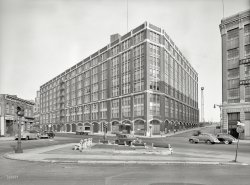
- Blizzard Dump: 1899
- ... by the Snowfall My wife and I spent 9 hours in Penn Station last Monday PM, about 12 blocks from the Flatiron Building, waiting for ... Posted by Dave - 08/20/2012 - 3:21pm -
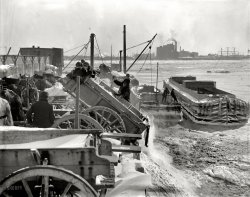
- The Scenic Route: 1941
- ... from the Bloomfield Bridge looking west to Pittsburgh and Penn station. The tall smokestack in the upper center exists today and was the ... Posted by Dave - 09/03/2020 - 11:41am -
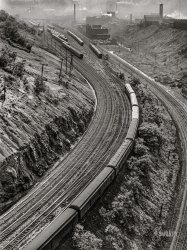
- Bus Stop: 1938
- ... City Subway", as it originates in a tunnel below Newark Penn Station and follows a subterranean right-of-way until it gets out of the heart ... Posted by John.Debold - 01/23/2017 - 4:28pm -
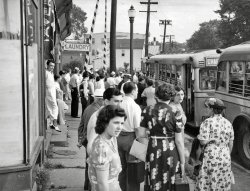
- For Them, Bombs: 1943
- ... here .
January 1943. "Chicago, Illinois. Union Station train concourse." Medium-format negative by Jack Delano for the Office ... too much of that other architectural massacre, New York's Penn Station.
Union Station: 2014 My photo below shows the same ... Posted by Dave - 01/18/2014 - 8:20am -
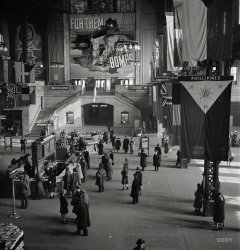
- R.F.K., R.I.P.: 1968
- ... City from Chicago came around the curve just south of the station. "The Admiral's" GG1 locomotive sounded its horn,a long loud blast, but ... four seriously injured.
After the tragic accident the Penn Central ordered all train movement stopped until the special train passed. ... Posted by Dave - 05/13/2013 - 8:54pm -
![R.F.K., R.I.P.: 1968 June 8, 1968. "Funeral cortege of Robert F. Kennedy." Thousands of people lined the tracks as the train carrying RFK's casket made the eight-hour journey from his funeral in New York to Washington, D.C. 35mm Kodachrome transparency. From photos by Paul Fusco and Thomas Koeniges for Look magazine. View full size.
CurlersThat was a common thing, to go out before your curls had set, and the butt of not a few jokes. Nobody does that anymore. Do they even still make curlers?
In the '80s, my dad worked next door to the Ambassador Hotel, where RFK was shot. I remember him taking me there and showing me the exact spot.
A further tragedyAs the funeral train approached Elizabeth, New Jersey, two people who were standing on an adjacent track to get a view of the funeral train were fatally struck by another train.
Two SidesWonder what the people looked like on the other side of the tracks.
Photographed From?Was this taken from the moving train, or from across the tracks?
Something Happening HereFusco's photos from the RFK funeral train (published in book form for the first time a few years ago) present a deeply moving group portrait of a specific instant in American history. You feel all of the country is on display, united, fleetingly, in confusion and grief. The blurred backgrounds, which contribute so much to the sense of the world unfurling outside the train window, were the unwanted but inescapable result of the ASA 25 film he was using.
Between this post and the previous two, there's a James Ellroy novel in the making.
Re: Photographed From?Definitely from the moving train.
As Hackensacker commented on the slow 35mm film, the blurred background is a result of the photographer panning the shot to keep the mid-ground people fixed in the frame. You can see a lesser degree of lateral blurring in the foreground foliage, as well.
Time warpI thought Kennedy was assassinated in 1963.
[Yes. -tterrace]
On display to the world "You feel all of the country is on display..."
Yes. When RFK was killed, my parents were stationed by the Foreign Service in Europe; we were in a restaurant in England right after we found out about the shooting, and there was a strong buzz of comments on the order of "These Americans shooting everyone who matters." The comments were genuinely aghast and puzzled, not mean spirited, but we were for sure on display to the world. Martin Luther King had just been shot at a moment when his fame and importance were growing overseas, and I had just been in a rather small "race riot" of demonstrations after his shooting; not a real riot, but exciting and disturbing stuff in my college town of Carlisle, Pennsylvania. As with JFK in 1960, RFK and MLK were overwhelmingly popular overseas, far more so than in there own country. I felt like a citizen of a surreal pariah nation that summer.
Three KennedysMr. WMtraveler. You are correct, but not totally right. There were three Kennedy Brothers, John (Jack), Robert (Bobby) and Edward (Teddy). Two of them were assassinated, John in 1963 and Robert in 1968.
[There were four Kennedy brothers. -tterrace]
Final, 60's version of a tradition?What a wonderful photo of the last gasp of funeral trains and of public observance of such grief. Very 60's. Can't recall any major public funeral trains after this one.
Elizabeth, NJ AccidentI was there. The crowd was so large I climbed a fence with a pole alongside. Stood on top of the fence with one arm around the pole, the other holding my camera.
Platforms were ground level and the crowd moved onto the tracks to get a view of the special train. "The Admiral",an express train heading to New York City from Chicago came around the curve just south of the station. "The Admiral's" GG1 locomotive sounded its horn,a long loud blast, but some of the people in the crowd did not clear the track in time and sadly two were killed and four seriously injured.
After the tragic accident the Penn Central ordered all train movement stopped until the special train passed. The funeral train arrived in Washington's Union Station four hours behind schedule and had caused disruption to the entire railroad.
RFK funeral trainDear all, (and AndyB who posted on 05/16/2013) can you please contact me? I would love to get in touch with bystanders of their relatives, who stood alongside the tracks and made photos or films of the funeral train of Robert F. Kennedy. As a Dutch photographer and teacher I am doing research on photography and memory. Even though I do work and live in the Netherlands, I sense that this event will still arouse vivid memories in the minds of many Americans. The images I am looking for don't have to be perfect, any visual material is welcome. I will gladly credit your photos and films wherever they’re used and I can compensate the potential expenses you need to make in digitizing the pictures. If you wish to learn more about my call, please, let me know. Thank you very much in advance for any kind of assistance!
Yours faithfully,
Rein Jelle Terpstra mail@reinjelleterpstra.nl
(LOOK, Railroads)](https://www.shorpy.com/files/images/SHORPY_22336u.thumbnail.jpg)
- Wood Street: 1910
- ... in the Post Building, before we moved our office over to Penn Avenue. It's still there, as is the Granite Building (which is ... intersection. The triangular building is now a subway station. The whole next block has been replaced, between Sixth and Oliver on ... Posted by Dave - 08/02/2012 - 7:41pm -
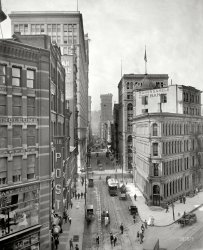
- All Aboard: 1910
- ... 1910. "Track level, main and exit concourses, Pennsylvania Station." 8x10 inch glass negative, Detroit Publishing Co. View full size. ... and there are duckboards across the tracks. Since the old Penn Station was completed in 1910, this photo looks like very soon before ... Posted by Dave - 10/03/2012 - 10:48am -
![All Aboard: 1910 New York circa 1910. "Track level, main and exit concourses, Pennsylvania Station." 8x10 inch glass negative, Detroit Publishing Co. View full size.
<sigh>We're looking at a crime scene.
Gone, but not forgotten.
It's amazing that they allowed some of the staircases to remain; every time I'm there, the gleaming/greening bronze and brass reminds me of what was.
"Circa" 1910Has to be very close! Station is pristine clean, and there are duckboards across the tracks. Since the old Penn Station was completed in 1910, this photo looks like very soon before opening.
StaircasesI wasn't aware they 'allowed' any staircases to remain; where are the originals- in the station?
[This photo of one and its location can be found on this page. - tterrace]
RivetsI love how they took the technology of the times and made it into an art form.
InterestingLooks like the same photo but with the duckboards edited out
DamnThats a beautifully restored picture of the concourse..
The picture taken of the stairs existing today is track 5 and 6. I just was there. It felt so good to touch it. And it's very heavy in person and thick too
Shorpy site... Please restore the picture of the main waiting room. You don't have that one up yet. It is the most beautiful waiting hall ever.
(The Gallery, DPC, NYC, Railroads)](https://www.shorpy.com/files/images/SHORPY_4a23719a.thumbnail.jpg)
- Parker, Bridget: 1921
- ... on what is now the National Archives, at Seventh St and Penn Ave NW. I believe the corner shown in the photo is now the Navy Memorial and a Metro station.
Bootblack's Dream Look at all the shiny shoes. It seems ... Posted by Dave - 09/03/2012 - 11:53am -
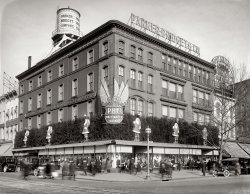
- Rail Disaster: 1933
- ...
This particular train would have originated in Penn Station behind an electric locomotive (probably a PRR P5). PRR steam replaced ... Posted by Dave - 07/02/2014 - 8:18pm -
![Rail Disaster: 1933
GRAVE OF MUD
WASHINGTON, Aug. 25, 1933 -- While thousands worked to overcome the havoc wreaked by the storm in the Capital, 300 trainmen struggled with the wreck of the Crescent Limited. The crack extra-fare express was hurtled yesterday from the tracks of the Pennsylvania Railroad when flood waters undermined the central abutment of the bridge over the Eastern Branch [Anacostia River], just inside the District. All day and all night the crews of railroad men worked, first with acetylene torches to clear debris from the approaches to the bridge, and then with three cranes to lift aside the wrecked cars. Late in the evening a derrick lifting the crushed engine from a grave of mud uncovered the body of the engineer, Arthur H. Bryde, of Washington. The body of J.H. Faye, the fireman, of Havre de Grace, was recovered earlier in the day. It had been ground into the mud of the embankment by a coach.
August 1933. Washington, D.C. "Crescent Limited train wreck." Another look at this wreck. Harris & Ewing Collection glass negative. View full size.
Men dead; locomotive saved.It's a K-4 Pacific type, seen many times on this site. Don't know what number it is, but it was definitely rebuilt. The first K-4 to be scrapped was #8309 in 1938, after a different wreck which occurred in Pittsburg when it plummeted off a high fill and then dropped another fifty feet over a concrete retaining wall into one of the city streets. The leading truck of the K-4 seen above is sunk in the mud dead-center of the photo.
Wrong truckOn a railroad, a truck is the assembly of wheels, springs, brakes, and centering devices which ride on the rails, supporting and guiding the car or locomotive it supports.
The engine is unmistakably, as pointed out, a Pennsylvania Railroad K-4 class 4-6-2 Pacific.
But, neither of the two trucks visible near the center of the photo came from that engine. K-4 pilot trucks were inside bearing. Perhaps, these were from under the tender, or from one of the passenger cars.
Re: Wrong TruckI stand corrected; how I missed them being outside bearing I have no idea. They probably are from beneath the tender, as the lead truck there is missing. Doubt they're from a car, as those appear to be all heavyweight equipment with six-wheel trucks.
LocomotivesWasn't the "Crescent" usually pulled by a Southern RR locomotive?
PRRA Southern 4-6-2 would pull it south of Washington. Guess this wreck must have been at the PRR bridge at 38.917N 76.9435W, where a PRR engine would pull the train.
Re: Re: Wrong truckThey are definitely Tender trucks. PRR Class 2D-T4 to be precise.
Crescent Question"Wasn't the "Crescent" usually pulled by a Southern RR locomotive?"
The Crescent Limited operated from New York to Washington on the Pennsylvania Railroad, on the Southern Railway from Washington to Atlanta, on the Atlanta & West Point / Western Railway of Alabama from Atlanta to Montgomery, AL, and on the Louisville & Nashville from Montgomery to New Orleans.
This particular train would have originated in Penn Station behind an electric locomotive (probably a PRR P5). PRR steam replaced the electric in Wilmington, DE; a Southern Railway Ps4 would take over in Washington (there may also have been an engine swap midway to Atlanta in Salisbury, NC). In Atlanta, WofA 190 or A&WP 290 (which were purchased specifically to haul this train) would take over, and an L&N locomotive would the train on the final leg of the journey.
(The Gallery, D.C., Harris + Ewing, Railroads)](https://www.shorpy.com/files/images/SHORPY-37162a.thumbnail.jpg)
- The Shopping Center: 1952
- ... left are in a triangle formed by South Middle Neck Road, Station Plaza, and Barstow Road, immediately the south of the Great Neck ... is the fact that it's a reasonably quick train ride from Penn Station. It is on the Port Washington line, which unlike the LIRR's other ... Posted by Dave - 12/10/2013 - 11:17am -
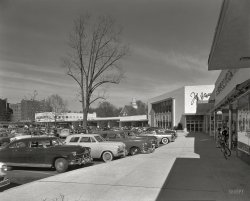
- Macy's: 1905
- ... there were probably Long Island Railroad Commuters. NYC's Penn Station is a few short blocks from Macy's.
Looking west This view shows ... Posted by Dave - 04/21/2014 - 6:24am -
![Macy's: 1905 1905. "R.H. Macy & Co., New York." The famous department store. Corner tenant: Lucio's, the jeweler whose pearls, rubies and diamonds "defy detection." 8x10 inch dry plate glass negative, Detroit Publishing Company. View full size.
A Bygone EraWhat a wonderful photo. I see several men carrying either a doctors bag or briefcase and everyone is dressed in their elegant finery, a far cry from what you would see today on any sidewalk. I often wonder what it was really like to have lived back then.
Happy Days Are Here AgainShortly after the U.S. ended Prohibition in December, 1933, R H Macy's was awarded New York State's first Liquor License. Attached is a news photo from 1944. The crowd there were probably Long Island Railroad Commuters. NYC's Penn Station is a few short blocks from Macy's.
Looking westThis view shows the eastern side of Macy's, with Broadway and Herald Square in the foreground. Most likely, the photographer was on the platform of the 34th Street station of the Sixth Avenue El, Sixth Avenue forming the opposite side of Herald Square. At the extreme right is the famous James Gordon Bennett Memorial statue, honoring the founder of the New York Herald newspaper from which the square took its name.
35th Street heads away from Broadway on the right side of the picture. Then as now, Macy's delivery and service entrances are along the 35th Street side. One thing apparent from the view of this side is that the Macy's building in 1905 was much smaller than it is today. Over the next 20 or so years it was expanded in stages to the west until it reached Seventh Avenue.
The Lucio's building on the corner of Broadway and 34th is part of Macy's lore, as when the store was in the planning stage Lucio's owner refused to sell. Whether he was trying to stop construction entirely or was just holding out for a big payoff is not certain. Whatever the case, Macy's simply built around the smaller building, and did not demolish it even after acquiring the property some years later. The building's still there today, on the ground floor housing what must be the world's best-located sunglasses shop, though it's best known for the huge Macy's advertising signs that cover the upper stories.
At lower left is a statue of copper mining baron William Earl Dodge, who became a leading philanthropist and helped organize the YMCA. It was sculpted by the famous sculptor John Quincy Adams Ward and dedicated in 1895. In the early 1940's it was moved several blocks away to Bryant Park to accommodate renovations to Herald Square.
Work CrewWhat a great photo! Truly a moment frozen for all time. I was drawn to the "manhole crew" at the lower right. Soft hats, no safety signs or extensive traffic barriers, woman crossing right over the cord, etc. A different world! Lack of auto traffic is certainly a factor. Can anyone elaborate on what the crew is doing? Is the tool powered by air or electricity?
Artificial, it seemsI've found other old ads for the company and they call them "scientific" diamonds -- and they "defy detection" is because you can't tell them from real "old mine" diamonds.
I think we'd call them now artificial - even back then, the technology was new but pretty good.
[Gem-quality synthetic diamonds, which are identical chemically (if not spectroscopically) to geologic ones, got their start in the 1970s. What Lucio's was selling is probably what we would call costume jewelry. -Dave]
Defy detection?Does that mean they can't be found, or they're so fake no one will be able to tell the difference?
(The Gallery, DPC, NYC, Stores & Markets, Streetcars)](https://www.shorpy.com/files/images/SHORPY_4a12205a.thumbnail.jpg)
- Temple of Transport: 1910
- Circa 1910. "Bird's-eye view of Penn Station, New York City." Also a bird's-eye view of someone's underwear and ... Posted by Dave - 05/18/2017 - 2:17pm -
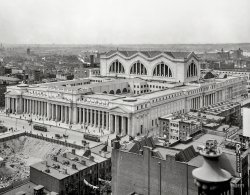
- Rush Job: 1941
- ... of the most famous structures in America, including old Penn Station:
http://harrysblack.com/GeorgeAFullerCompany.html
Licence ... Posted by Dave - 12/30/2012 - 8:58am -
![Rush Job: 1941 December 1941. Washington, D.C. "Workmen at lunch hour on emergency office space construction job." Photo by John Collier. View full size.
Waiting for Mess CallThere seem to be several birds sitting patiently in the tree, waiting their chance at the crumbs. Too bad that the characterless nature of wartime government architecture makes placing this photo more precisely very difficult. The buildings in the background could be anything from the Navy Annex or Henderson Hall to the tempo buildings that persisted on the National Mall until the mid-'60s.
Working Class: The Power of a ButtonThese fellows clearly take pride in being union members. No scabbing on this job. Everyone has their union button prominently displayed. That may have been a factor in politicians of that era remembering that there wasn't only a middle class, but a working class, too, who had a stake in the American Dream.
Drop and walkGeez, come on! One guy is sitting ankle deep in trash, the gutter is filling up...doesn't a construction crew have at least a bucket?
Emergency?Having trouble here trying to figure out how a shortage of office space would constitute an emergency.
[Date and place are relevant here. - tterrace]
The George A. Fuller CompanyThe construction firm in charge of the site shown here built some of the most famous structures in America, including old Penn Station:
http://harrysblack.com/GeorgeAFullerCompany.html
Licence PlateZoomed in the picture is a bit fuzzy, but is that Licence Plate dated 1942?
[1941 District of Columbia license plates were good through March 31, 1942. - tterrace]
(The Gallery, Cars, Trucks, Buses, D.C., John Collier, WW2)](https://www.shorpy.com/files/images/SHORPY_8c33619a.thumbnail.jpg)























